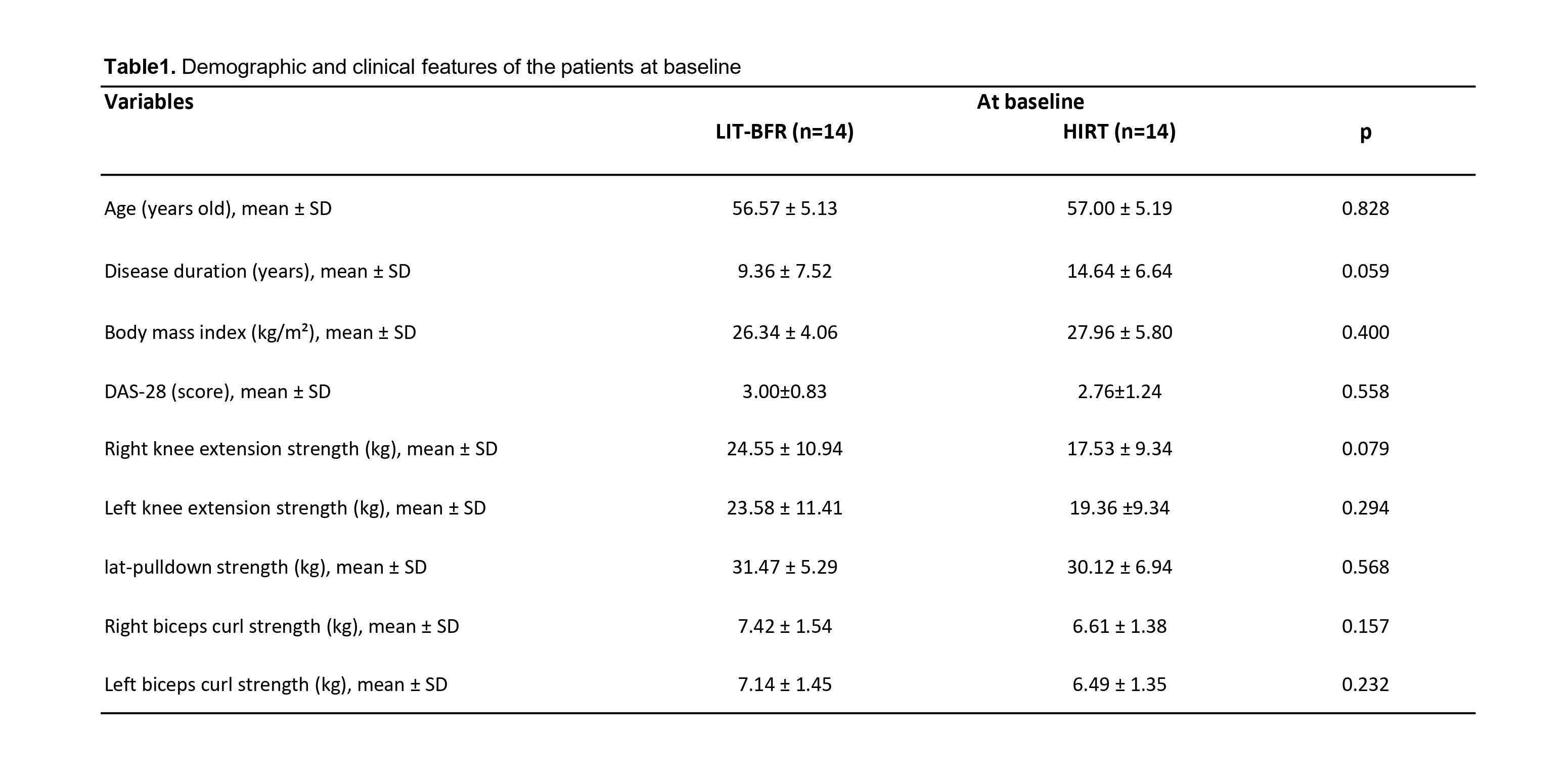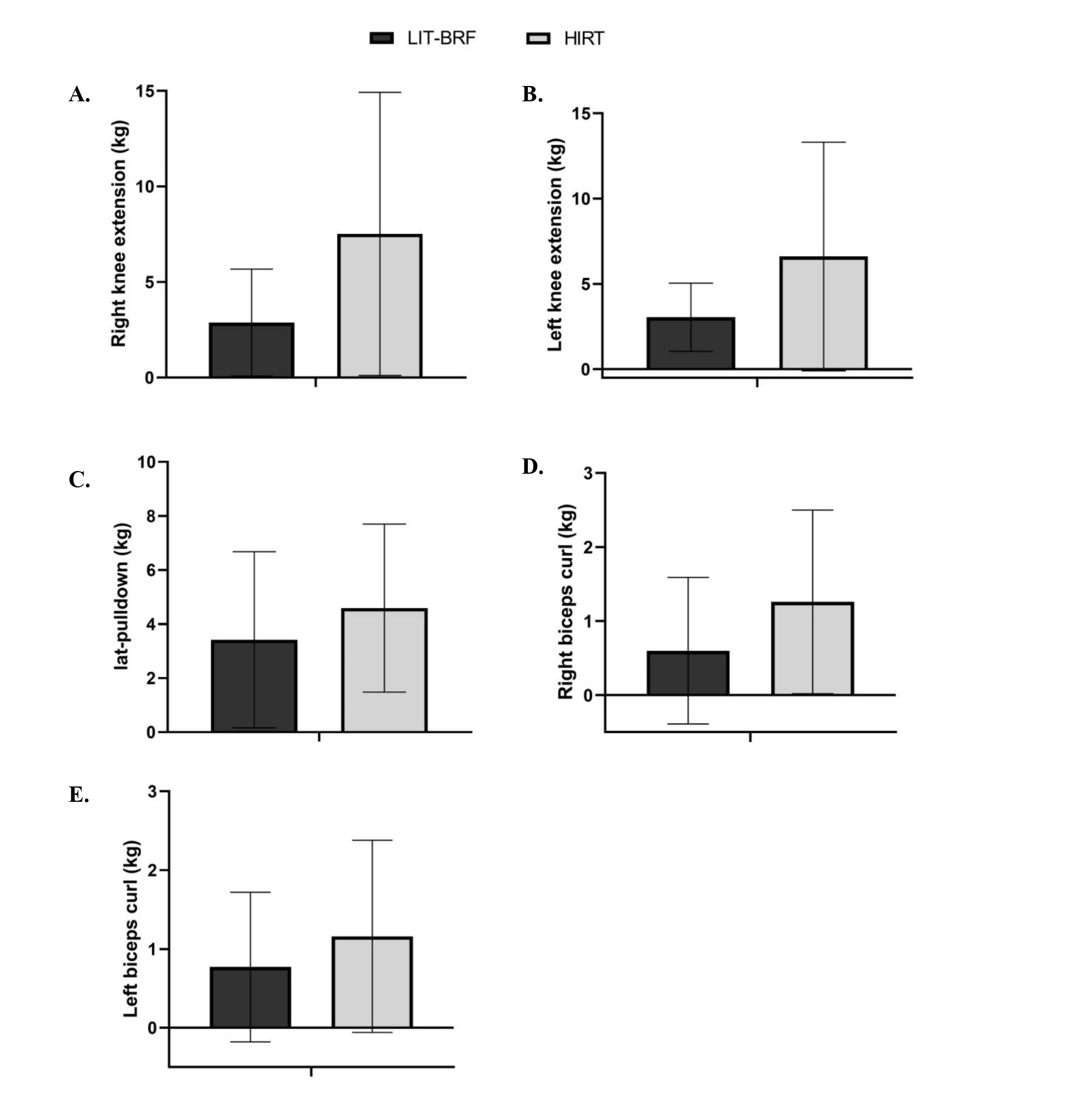Session Information
Date: Sunday, November 17, 2024
Title: RA – Treatment Poster II
Session Type: Poster Session B
Session Time: 10:30AM-12:30PM
Background/Purpose: Rheumatoid arthritis (RA) is an autoimmune inflammatory disease that often leads to decreased muscle strength and muscle mass. High intensity resistance training (HIRT), using loads ranging from 70-85% of one-repetition maximum (1RM), has been shown to be effective in improving these parameters in RA patients. However, when accompanied by negative disease outcomes such as pain and fatigue, HIRT may lead to joint discomfort and demonstrate low adherence. Thus, low-intensity training with blood flow restriction (LIT-BFR), using loads ranging from 15-30% of 1RM, could be a viable alternative for these patients. Therefore, our purpose was to verify the equivalence between the LIT-BFR and HIRT protocols on muscle strength in women with RA.
Methods: In a randomized clinical trial, RA women were randomized to either HIRT (80% 1RM) or LIT-BFR (30% 1RM) in a 12 weeks training protocol, with sessions twice a week. The training protocol was composed by unilateral knee extension, lat-pulldown, and unilateral biceps curl exercises. Disease activity was assessed by DAS-28. Muscle strength was measured by 1RM tests of knee extension, lat-pulldown and biceps curl. A margin of 5.5 kg was used to verify equivalence of muscle strength between the groups. Data were analyzed using intention-to-treat principles. Independent samples t-test, paired t-test, and univariate analysis of variance were conducted, considering p< 0.05 as significant difference.
Results: 28 patients (14 in each group) were recruited and analyzed. 26 patients completed the training. One patient from the HIRT group discontinued the study after 4 weeks of training, reporting difficulties attributed to the training load. Another patient from the LIT-BFR group discontinued after 1 week of training, reporting paresthesia. The adherence rates to the training protocol were 87.8% and 83.7% for HIRT and LIT-BFR, respectively. At baseline, groups were homogeneous for age, disease duration, body mass index (BMI), disease activity and muscle strength (Table 1). After 12 weeks of training, the mean increase of strength of right knee extension was 2.88 ± 2.80 kg for LIT-BFR vs. 7.52 ± 7.41 kg for HIRT; mean difference -4.316 kg (95% CI, -9.021 to 0.388), p=0.070. For left knee extension, the mean increase was 3.05 ± 2.00 kg for LIT-BFR vs. 6.61 ± 6.70 kg for HIRT; mean difference -3.418 kg (95% CI, -7.417 to 0.582), p=0.091. Therefore, equivalence was not demonstrated for knee extension. Conversely, groups demonstrated equivalent increases in lat-pulldown strength: 3.42 ± 3.26 kg for LIT-BFR vs. 4.59 ± 3.11 for HIRT; mean difference -1.106 kg (95% CI, -3.639 to 1.426), p=0.377. Similarly, both groups were equivalent in right biceps curl strength: 0.60 ± 0.99 kg for LIT-BFR vs. 1.26 ± 1.24 for HIRT; mean difference -0.628 (95% CI, -1.552 to 0.295), p=0.173, and left biceps curl strength: 0.77 ± 0.95 kg for LIT-BFR vs. 1.16 ± 1.22 for HIRT; mean difference -0.422 (95% CI, -1.312 to 0.468), p=0.338 (Figure 1).
Conclusion: Except for the knee extension, LIT-BFR was equivalent to the HIRT in improving muscle strength in RA women, demonstrating it to be a well-tolerated and effective tool for preventing and improving sarcopenia in these patients.
To cite this abstract in AMA style:
dos Santos L, Santo R, Ramis T, Mallmann A, Moraes D, Dória L, Pilotti S, Grave G, Bueno N, Silveira A, Santos C, Chakr R, Monticielo O, Brenol C, Xavier R. Effects of Training with Blood Flow Restriction on Muscle Strength in Women with Rheumatoid Arthritis: A Randomized Clinical Trial [abstract]. Arthritis Rheumatol. 2024; 76 (suppl 9). https://acrabstracts.org/abstract/effects-of-training-with-blood-flow-restriction-on-muscle-strength-in-women-with-rheumatoid-arthritis-a-randomized-clinical-trial/. Accessed .« Back to ACR Convergence 2024
ACR Meeting Abstracts - https://acrabstracts.org/abstract/effects-of-training-with-blood-flow-restriction-on-muscle-strength-in-women-with-rheumatoid-arthritis-a-randomized-clinical-trial/


